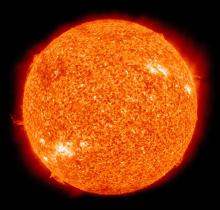Listen to today's episode of StarDate on the web the same day it airs in high-quality streaming audio without any extra ads or announcements. Choose a $8 one-month pass, or listen every day for a year for just $30.
You are here
Gustav Spörer
The Sun sometimes takes a nap. It can go for decades without producing many sunspots. That has a big impact on space weather, and maybe on Earth’s climate.
One of those naps is known as the Spörer Minimum. It was discovered by Gustav Spörer, a German astronomer who was born 200 years ago today.
Spörer earned his PhD by studying a comet. In his late 30s, though, he turned his attention to sunspots — dark blotches on the Sun. Today, we know they’re cool magnetic storms. At the time, though, their nature was unknown.
Astronomers had found that the spots follow an 11-year cycle. There are lots of spots at the cycle’s peak, but few at its low point. Spörer and others found that no two cycles are alike. Some are quiet, with few spots. And there can be periods with several quiet cycles in a row.
The most famous is the Maunder Minimum, discovered by Spörer and by Edward Maunder. It came in the late 17th and early 18th centuries. The Spörer Minimum came a couple of centuries earlier. There’s evidence that space weather — an interaction between Earth and the Sun — was quieter then. And Earth’s climate was a little cooler during those periods — an indication that the Sun’s energy output was lower than normal.
Spörer discovered that sunspots migrate from high latitudes toward the equator during the 11-year cycle. He also discovered that different latitudes of the Sun rotate at different rates — insights into the Sun and its long naps.
Script by Damond Benningfield






